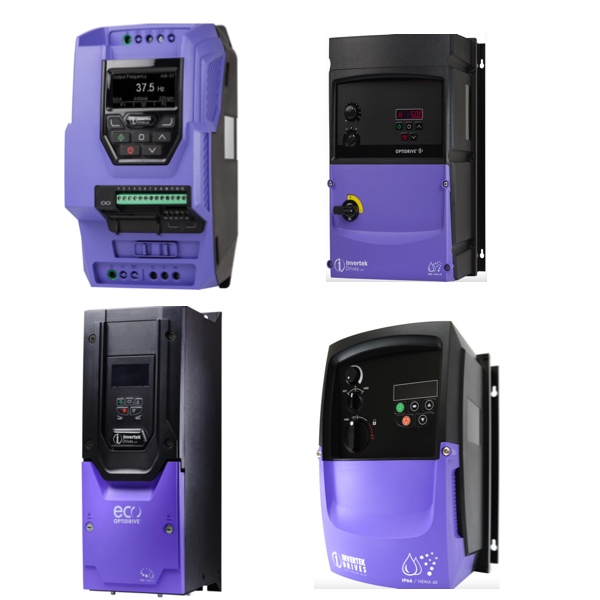
Invertek VFDs

Invertek Variable Frequency Drives (VFDs) are built for high efficiency and reliability. They incorporate advanced control algorithms that allow for smooth, precise speed regulation, optimal torque control, and process optimization. These drives can operate in various control modes, such as V/Hz control, sensorless vector control, or closed-loop vector control. As a result, Invertek VFDs can handle a wide range of applications with ease — from pumps to fans and from conveyor systems.
Invertek drives are built to take on tough environments with sturdy cases that keep out dust and moisture and protect the circuit boards from other contaminants. VFDs in the Invertek line come with various IP ratings, which means you can install them indoors or outdoors. And a compact design allows for easy integration into systems.
Invertek VFDs have a major upside when it comes to energy efficiency. They use motor speed to match load demands and consume less energy. This provides particular benefits for applications with variable loads, such as air conditioning systems and pumping stations, where the possibility of saving energy exists. An Invertek VFD can even help reduce peak demand during periods when electricity rates are high.
Products
More Information about Invertek Variable Frequency Drives
Invertek Optidrive E3 General Purpose Drives
Invertek Optidrive E3 General Purpose Drives provide sensorless vector control for all motor types including: induction motors, permanent magnet motors, brushless DC motors, synchronous reluctance motors and line start PM motors. Optidrive E3 drives provide simple installation, motor connection and commission. With just 14 basic parameters and application macro functions, set-up and start-up are quick and easy. The Industrial, Pump and Fan modes can be used to suite specific HVAC and pumping applications.
Invertek Optidrive P2 High Performance Drives
Invertek Optidrive P2 High Performance Drives provide 150 percent overload for 60 seconds as standard, ensuring each drive is suitable for Heavy Duty applications. The IP55 enclosed units allow the drive to survive in industrial environments. Optidrive P2 is designed to work with a wide range of motor types and extensive I/O and communications interface capabilities ensure that the drive can be integrated into a variety of control systems.
Invertek Optidrive Eco HVAC Drives
Invertek Optidrive Eco HVAC Drives optimize the performance of pumps and fans used in HVAC applications. They are used with AC induction motors, AC permanent magnet motors, brushless DC motors and synchronous reluctance motors. For simple installation into a building's management system, all Optidrive Eco HVAC drives are provided with both BACnet and Modbus RTU as standard.
FAQs
What is the output amperage and output voltage of a single phase Invertek VFD?
The output amperage and output voltage of a single-phase Invertek VFD can vary, but typically, the output voltage ranges from 0 to the input supply voltage (up to 240V for a 230V input model), and the output amperage can range from a few amps to around 15-25 amps depending on the specific model and application.
Motor Starters
Motor starters safely start and stop a motor in industrial applications. They are designed with a contactor, overload and circuit protection. They are used when basic motor control is required, where torque on the motor is not a concern and motor speed control is not needed. The advantages of motor starters include: lower cost, allows for remote operation, allows for monitoring of motor state (with the use of auxiliary contacts) and they are safe and efficient. The disadvantages include: high inrush current that can cause fuses to blow and breakers to trip if the inrush is too high, and the starter will allow a full torque to start the motor which can cause the motor to ramp up to full speed very quickly potentially causing the motor to wear and degrade prematurely.
Soft Starters
Soft starters protect motors from inrush current by gently ramping up the motor to full speed. They provide all of the same functions as a traditional motor starter. The advantages of soft starters include: they are less expensive than a VFD when only startup control is needed, they are a smaller system than a VFD where space is a concern and they prevent unwanted torque upon startup, prolonging the life of the motor. The disadvantages include: they are more expensive than a traditional motor starter and they do not allow for full speed control.
Variable Frequency Drives
Variable Frequency Drives (VFDs) allow for the slow ramp up of a motor during startup and the slowing down of the motor during shutdown. They also allow for full speed control during the entire run cycle of the motor. VFDs provide the same functions as both the traditional motor starters and soft starters. The advantages of VFDs include: full speed control (start, stop and in-between), more custom control and monitoring, energy savings due to efficient motor usage and less wear and tear on the motors. The disadvantages include: they are more expensive and larger than other motor control options and they generate heat that may require fans or AC units.

